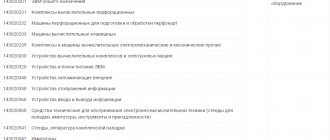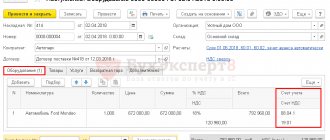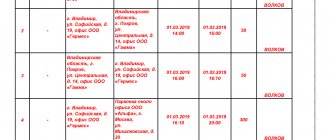Resistance classes
Of course, when labeling models, manufacturers indicate the resistance class and depreciation period. It is believed that the first number in the marking indicates this. However, everyone understands that this method of determining the service life of a car is questionable. Ideally, you need to look at the real experience of other drivers using the car, read reviews and get other practical data. It is generally accepted that new cars with the first, second or third class last from 3 to 5 years, cars of the fourth class will last 5-7 years, cars of the fifth are designed for 7-10 years of service.
Are cars included in the fixed assets register?
Motor transport can be considered a fixed asset (FPE) both in tax accounting and accounting if the criteria prescribed by law are met.
Criteria for inclusion in the register of fixed assets of a company in tax accounting in accordance with paragraph 1 of Art. 257 of the Tax Code of the Russian Federation:
- exploited in the process of producing and selling products, providing services, carrying out work, and managing an enterprise;
- the cost of the object starts from one hundred thousand rubles .
Criteria for inclusion in the register of fixed assets of a company in accounting in accordance with Order of the Ministry of Finance of Russia dated March 30, 2001 No. 26n “On approval of the Accounting Regulations “Accounting for Fixed Assets” PBU 6/01”:
- is exploited in the process of producing and selling products, providing services, carrying out work, managing an enterprise, leasing it temporarily for a fee;
- has been in use for more than a year >;
- the company does not intend to resell the property;
- it is planned to make a profit in the future .
Depreciation calculation
The cost of fixed assets is repaid through depreciation (clause 17 of PBU 6/01, clause 49 of the Guidelines for accounting of fixed assets). When using the linear method of calculating depreciation in accounting, the annual amount of deductions is calculated based on its original cost and the depreciation rate, calculated taking into account the useful life of the fixed asset, established by the company when accepting the fixed asset for accounting (clause 18, paragraph 2, clause. 19 PBU 6/01, paragraph “a”, paragraph 54 of the Guidelines for accounting of fixed assets).
Depreciation begins on the 1st day of the month following the month the object was accepted for accounting, and stops on the 1st day of the month following the month of full repayment of the cost of the object, or its write-off from accounting (clause 21 PBU 6/01 , paragraph 61 of the Guidelines for accounting of fixed assets).
Depreciation charges are recognized in accounting as expenses for ordinary activities in the month of their accrual (clauses 5, 8, 16, 18 of the Accounting Regulations “Organizational Expenses” PBU 10/99, approved by order of the Ministry of Finance of Russia dated May 6, 1999 No. 33n, clause 64 of the Guidelines for accounting of fixed assets).
note
The company's costs associated with the rental of a vehicle used for management needs are classified as expenses for ordinary activities and are recognized monthly in the amounts established by the contract.
Depreciation on a car used for management needs is reflected in the debit of account 26 “General business expenses” (44 “Sales expenses” - for trade organizations) and the credit of account 02 “Depreciation of fixed assets” (clause 25 of PBU 6/01, clause 65 Guidelines for accounting of fixed assets, Instructions for using the Chart of Accounts).
Read also: “Depreciation of a passenger car”
What determines the actual service life of a car?
Standard service life calculations for a private owner are irrelevant. They are taken into account only for the financial statements of companies that have cars on their balance sheets. A private owner only needs to know that the car will behave normally in different situations on the roads and will be able to deliver it from one point to another.
It is possible to derive many criteria that affect the actual service life of a car, regardless of which class it is assigned to.
- Mileage per year. Of course, one of the most important factors is the one that determines how long the machine will last. If a car sits in a garage for ten years, it will only lose its appearance, but the condition of the internal parts and friction pairs will be ideal. Some drivers' cars cover 30-40 thousand kilometers per year. Naturally, the service life of such vehicles will be shorter in years.
- Transport storage. This is another important factor that plays a role and determines the condition of the car. If the car is always on the street, then corrosion will occur on the body. When stored in a garage, corrosion can be avoided for many years.
- Timely maintenance of the machine and replacement of all prescribed “consumables” on time. The manufacturer indicates in the instructions at what mileage or time it is necessary to change the oil, air, gasoline, oil filters, etc.
- Use of original consumables and spare parts during maintenance. Often there are analogues on the market that are cheaper than original spare parts. It is not recommended to use them.
- Quickly eliminate problems that arise during the operation of transport.
- Driving style, attitude towards the car.
- Condition of the roads. Cars in Europe last much longer than the same brands in Russia. One of the reasons is the quality of the road surface. If the vehicle drives on a perfectly smooth road with no potholes most of the time, it will last longer. In Russia and the CIS countries, the condition of roads is noticeably worse, which explains the frequent repairs of vehicle chassis.
Determination of the depreciation group of passenger cars
According to the generally accepted classification in force in the Russian Federation, passenger cars are divided into 5 classes. The key criterion for such a division is engine size. It looks like this:
- class 1 - includes cars with engine volume less than 1.2 liters;
- class 2 - volume varies between 1.2-1.8 liters;
- class 3 - cars with an engine capacity of 1.8-3.5 liters;
- class 4 - vehicles with an engine capacity exceeding 3.5 liters;
- class 5 - executive cars, the engine size of which does not play a decisive role.
Important! Executive class cars of domestic production have a numerical classifier “5”, which is placed first in the model number. For foreign-made vehicles, such a classification is not provided: whether a car belongs to the highest class is determined by the manufacturer.
Classification of Russian cars
To determine the class of domestic cars, it is enough to pay attention to the model number: the first digit corresponds to the class. For example, VAZ 2109 indicates that the vehicle belongs to class 2, has an engine capacity of 1.2-1.8 liters, and has a useful life of 3-5 years.
An example of calculating the useful life period
We purchased a used Suzuki car that had been in use for a year and a half. The engine capacity of the car is 2.5 liters. Using these data as a basis, you can easily calculate the useful life. To do this you need to follow 3 simple steps:
- determination of depreciation group - engine size indicates that the car belongs to group 3;
- useful life period (total) - for this group the terms vary between 3-5 years;
- useful life period (remaining) - the operating period is subtracted from the total life.
As a result, the useful life period will be 1.5-3.5 years.
Executive class car
Considering that luxury cars are not determined by engine size criteria, other parameters apply to them. There are 3 main indicators:
- length - more than 5 meters;
- width - from 1.7 meters;
- model - by default, luxury vehicles include Mercedes, BMW, Lexus and other cars with the prefix “premium”.
The following parameters play a secondary determining role:
- market price;
- speed characteristics;
- body type;
- interior comfort;
- security: reservation.
It should be clarified that a combination of primary and secondary characteristics helps classify a car as a representative class. For example, a car may fit this category in terms of body size and model, but not according to secondary indicators. In this case, the car is included in depreciation group 3-4.
In addition, Russian and European classifications differ significantly. For example, in the Russian Federation, cars are divided according to engine size, while in Europe size is considered a key parameter. Therefore, the manufacturer’s statement that a foreign car belongs specifically to the executive class is not always true. Therefore, in order to classify a car as the highest category, an expert opinion is required.
How to determine the useful life of vehicles
Based on the norms of Art. 258 of the Tax Code, the useful life of vehicles is the expected period of operation of the facility. In order to put the car into operation, it is necessary to establish the SPI within the time limits according to the Classifier and indicate it in the act in the OS-1 form. Please keep in mind that:
- 1 especially small class of passenger vehicles are cars with an engine capacity of no more than 1.2 liters.
- 2 small class - no more than 1.8 liters.
- 3 middle class - no more than 3.5 liters.
- 4 large class - more than 3.5 liters.
- 5th highest class - executive (in accordance with the explanations of the Customs Committee in Letter No. 04-30/3515 dated February 26, 1997).
For example, a VAZ 2114 car belongs to class 2, as indicated by the first number 2 in the model name. Consequently, group 3 is selected for calculating depreciation: SPI is set at 37 months. (ranging from 37 months to 60 months). Approval of the same period in NU and BU will avoid the occurrence of differences in subsequent calculations.
Method for calculating SPI in tax documentation using the Classifier
In the Decree of the Government of the Russian Federation dated January 1, 2002 “On the Classification of fixed assets included in depreciation groups,” you can see the SPI Classifier according to the depreciation groups of transport.
All vehicles belong to separate depreciation groups; the group number is affected by the vehicle type, size, power, and area of operation.
For all cars, the SPI can vary from two to nine years .
The SPI TS classifier can be presented as the following table :
| No. | Depreciation group | SPI, years | Kind of transport |
| 1 | 2 | from two to three | Utility lifts with platforms |
| 2 | 3 | from three to five |
|
| 3 | 4 | from five to seven |
|
| 4 | 5 | from seven to nine |
|
Purchasing a used car: how to determine its useful life?
A government agency acquired a fixed asset item (a passenger car) that had previously been in use. How to determine its useful life in order to accept it for budget accounting and calculate depreciation?
In accordance with paragraph 44 of Instruction No. 157n[1], the useful life of a fixed asset is the period during which it is intended to be used in the course of the institution’s activities for the planned purposes.
As a general rule, determining the useful life of fixed assets (including objects that were previously in operation) for the purpose of accepting them for accounting and calculating depreciation is based on:
- information contained in the legislation of the Russian Federation establishing the useful life of property for the purpose of calculating depreciation;
- recommendations contained in the manufacturer's documents included in the package of the property (in the absence of norms in the legislation of the Russian Federation providing for the useful life of the property for the purpose of calculating depreciation);
- the decision taken by the institution’s commission on the receipt and disposal of assets (in cases of lack of information in the legislation of the Russian Federation and the manufacturer’s documents).
In accordance with the Classification of fixed assets included in depreciation groups, approved by Decree of the Government of the Russian Federation dated January 1, 2002 No. 1 (hereinafter referred to as the OS Classification), passenger cars belong to the third depreciation group (property with a useful life of more than three years to five years inclusive ( code OKOF 15 3410010)).
According to para. 3 clause 44 of Instruction No. 157n for fixed assets included in depreciation groups from the first to the ninth, the useful life is determined by the longest period. Therefore, the useful life of the car will be five years (60 months). You should know that for fixed assets that were previously in operation, the end date of their useful life is determined taking into account the period of their actual operation (paragraph 12, clause 44 of Instruction No. 157n). That is, institutions, for the purpose of calculating depreciation for these objects, have the right to provide for a depreciation rate taking into account the useful life, reduced by the number of years (months) of operation of this property by the previous owners.
If the period of actual use of the object by the previous owners turns out to be equal to its useful life, determined by the OS Classification, or exceeds this period, the institution has the right to independently determine the useful life of the car, taking into account safety requirements and other factors. This conclusion is based on the provisions of tax legislation (paragraph 2, paragraph 7, article 258 of the Tax Code of the Russian Federation). We believe that the useful life of fixed assets that were previously in use should be determined in a similar way in order to accept them for budget accounting.
The actual service life of a used fixed asset must be documented. If there are no documents, then the useful life is established in accordance with the Classification of fixed assets, as for a new fixed asset (letter of the Ministry of Finance of the Russian Federation dated June 16, 2010 No. 03-03-06/1/414, dated September 23, 2009 No. 03-03-06 /1/608).
Please note that depreciation on fixed assets that were previously in use is calculated in accordance with the generally established procedure provided for in clauses 85, 86 of Instruction No. 157n (in a straight-line manner starting from the 1st day of the month following the month the object was accepted for accounting), and is carried out until the cost of this object is fully repaid or it is written off from the register. The annual depreciation amount is calculated based on the book value of the property and the depreciation rate calculated taking into account its useful life. During the financial year, depreciation is calculated monthly at 1/12 of the annual amount.
For clarity, let's give an example.
A government agency purchased a previously used passenger car worth RUB 420,000. The period of its actual operation by the previous owner is documented and is 2 years 8 months. (32 months). It is necessary to determine the useful life of the car and the amount of monthly depreciation charges.
According to the OS Classification, the total useful life of a passenger car is five years (60 months).
At the time the car was accepted for registration, it had already been in use for 2 years and 8 months. (32 months), so its remaining useful life will be 2 years 4 months. (28 months) (5 years (60 months) - 2 years 8 months (32 months)).
Every month during the specified period, depreciation will be charged in the amount of 15,000 rubles. (RUB 420,000 / 28 months).
[1] Instructions for the application of the Unified Chart of Accounts for public authorities (state bodies), local governments, management bodies of state extra-budgetary funds, state academies of sciences, state (municipal) institutions, approved. By Order of the Ministry of Finance of the Russian Federation dated December 1, 2010 No. 157n.
Hello Guest! Offer from "Clerk"
Online professional retraining “Accountant on the simplified tax system” with a diploma for 250 academic hours . Learn everything new to avoid mistakes. Online training for 2 months, the stream starts on March 1.
Sign up
How is it calculated in accounting?
The accounting legislation does not have a clear time frame for limiting private investment.
An enterprise can establish the SPI according to the Classifier used for tax accounting, or set its other value, guided by certain factors.
According to clause 20 of PBU 6/01, the factors influencing the SPI of motor transport are:
- expected duration of further operation of the vehicle;
- documentary restriction of SPI of transport (end of a rental or leasing agreement for vehicles);
- operating conditions of transport : weather conditions, frequency of shifts, territorial features of the area of application, etc.
Bus
For buses, the service life differs depending on the length, area of application (city, intercity):
- from 7 to 9 years (85 - 108 months inclusive) - other bus trains with a length of 16.5 to 24 m;
- from 5 to 7 years (61 – 86) – city bus trains from 16.5 to 24 m, other medium and large buses (up to 12 m), as well as long-distance buses;
- from 3 to 5 years (37 – 62) – city and other small buses up to 7.5 m.
That is, in order to correctly determine the SPI, you need to know the dimensions of the bus (its length), as well as its scope.
Example
PAZ 32053 with a gasoline engine is used for passenger transportation within the city, has a length of 6.925 m.
Such a bus can be classified as depreciation group 3 as an urban small type with a length of up to 7.5 m (OKOF 310.29.10.30.111).
The useful life can be selected from the range from 37 to 62 months inclusive.
Depreciation group of vehicles
Establishing the SPI of any car depends on its technical characteristics. In most cases, this is the purpose of the vehicle, load capacity, and engine type. The required data is indicated in the model's PTS (lines 2-4) or the operating manual. In order for the depreciation of vehicles to be calculated correctly in the accounting of an organization, it is necessary, first of all, to establish a group according to the OS Classifier approved in Resolution No. 1 of 01/01/02. This directory was updated from 01/01/17 with the entry into force of Resolution No. 640 of 07/07/16
The new requirements must be applied to those vehicles that were put into operation already in 2022. If the property began to be used earlier than the specified date, depreciation should be calculated in the same manner. According to the Classification, almost all passenger cars (classes 1-3) belong to group 3 with STI from 3 to 5 years. (code 310.29.10.2). More precisely, the group can be established by vehicle class - small, extra small, medium or large, depending on the engine size.
But if a passenger car is classified as class 4, that is, intended to be driven by a disabled person (code 310.29.10.24), group 4 is established with SPI from 5 to 7 years. And expensive class 5 passenger vehicles depreciate even longer - from 7 to 10 years, and group 5 is approved for them. The highest class is, according to officials, executive models, for example, Mercedes-Benz CLS, Lexus, Jaguar, SAAB, etc.
Trucks
SPI for trucks is calculated based on the load capacity and area of application of the vehicle:
- from seven to nine years – trucks, the cargo weight of which is from 3.5 to 12 tons, trailers, semi-trailers;
- from five to seven years – dump trucks, vans, special equipment;
- from three to five years – small cars with a carrying capacity of up to 3.5 tons.
For example, KamAZ can be included in the group of dump trucks.
Accordingly, its depreciation group is 4, that is, its SPI is in the range from five to seven years
What licenses are needed for a Gazelle with a cargo trailer?
To drive a Gazelle cargo truck with a trailer, you will need to obtain a license with a whole list of categories: “C”, “CE”, “B”, “BE” and “D”.
If the loaded maximum weight of the Gazelle is up to 3.5 tons:
- for a light (up to 750 kg) trailer, category “B” is enough;
- for a heavier (more than 750 kg) trailer, you will need (if the total weight of the vehicle exceeds 3.5 tons) the “BE” category.
Naturally, there may be situations where category “B” may not be enough to drive this car and category “C” will be needed to drive a truck.
In what situations does a Gazelle need category “C”?
If the loaded maximum weight of the Gazelle is more than 3.5 tons:
- together with a light (up to 750 kg) trailer, the car requires driver category “C”;
- in cases where the weight of a car with a heavy trailer is more than 3.5 tons, you will need a “CE” license category.
This is explained by the fact that there are various modifications of the model, for example, an extended version of the Gazelle - GAZ-33022 has a maximum permitted weight of 3.6 tons. Even though you may not plan to use this full potential, the law still requires you to have a “C” driving category.
Is it necessary to establish SPI to calculate vehicle depreciation?
If a car is registered as a fixed asset, then the organization is obliged to establish a depreciation group for it in tax accounting, in accordance with which the useful life for tax purposes will be determined.
Also, SPI must be established to include the cost of a car as an expense in accounting.
The organization accrues depreciation on the vehicle throughout its entire service life until complete physical wear and tear is reached or until the object is disposed of or written off.
How to determine it in accounting?
Accounting legislation does not contain clear restrictions on the duration of the useful life.
Clause 20 of PBU 6/01 explains what factors should be paid attention to when determining the service period.
At the same time, there is no prohibition to be guided in this matter by the Classifier established for tax purposes.
That is, if it wishes, the company has the right to establish the same SPI in accounting for a car as for tax purposes under the Classification of fixed assets.
At the same time, you can set another period that is appropriate for a particular vehicle, and you should take into account:
- scope of application of the vehicle;
- planned operating time;
- influencing factors - climatic conditions where the car will be used, territorial features, characteristics of the place of operation - urban or rural, frequency of use, procedure for maintenance and repair, as well as a number of other influencing circumstances;
- existing restrictions - for example, the lease or rental period.
Classification and assessment of cars
Based on the provisions of FAS 6/2020 “Fixed Assets”, in force from 2022 (until 2022 - PBU 6/01 “Accounting for Fixed Assets”), the car is classified as fixed assets (FPE).
Since 2022, PBU 6/01 has lost force. Instead, FSBU 6/2020 “Fixed Assets” and FSBU 26/2020 “Capital Investments” apply. ConsultantPlus experts explained in detail how to correctly take into account changes in the initial cost of an operating system when applying new standards. Get free demo access to K+ and go to the Ready Solution to find out all the details of this procedure.
The exceptions are cars purchased for resale (in which case they are considered goods) and cars produced in an enterprise (in which case they are accounted for as finished goods).
Find out what property is considered a company's fixed assets here.
For accounting purposes, cars as fixed assets are divided according to the following criteria:
- Depending on the purpose of use in the enterprise’s activities: production or non-production.
- Depending on the degree of use: in stock, in operation, mothballed, leased.
- Depending on ownership: own and rented.
Before capitalizing the received car on account 01 “Fixed assets”, the accountant accumulates all associated costs on account 08 “Investments in non-current assets”. The accountant writes off the costs accumulated on account 08 to the debit of account 01 when bringing the car into a condition in which it can be used.
This type of property is taken into account at its original cost. It is determined at the time of commissioning and remains unchanged throughout the entire period of stay at the enterprise.
Depending on the source of receipt of the car, its initial cost will be:
- When purchasing - the cost determined by the purchase and sale agreement (excluding VAT), including the cost of: information services; services related to purchase, delivery; intermediary costs; customs and other duties and fees; interest on the loan.
Example
Fortuna LLC purchased a new Ford car from a car dealership worth RUB 1,200,000. without VAT
The state fee paid for registering a car was 2,000 rubles.
Fortuna's accountant prepared the following entries:
- payment was transferred to the car dealership for the car: Dt 60 Kt 51 - 1,200,000 rubles;
- the car came from a car dealership: Dt 08 Kt 60 - 1,200,000 rubles;
- Fortuna LLC transferred the state duty from the account: Dt 68 Kt 51 - 2,000 rubles;
- the cost of paying the duty is taken into account when determining the initial cost: Dt 08 Kt 68 - 2,000 rubles.
- the car was put into operation: Dt 01 Kt 08 - RUB 1,202,000.
- When making a contribution to the authorized capital - the cost of the car as determined by the appraiser.
Example
Participant of LLC "Style" P. P. Borisov made a contribution to the authorized capital of LLC with a Volvo car. In the report of an independent appraiser presented by Borisov, the car was valued at 800,000 rubles.
The company accountant will perform the following actions:
- Borisov's debt to pay for his share in the authorized capital is reflected: Dt 75 Kt 80 - 800,000 rubles;
- Borisov transferred a Volvo car as payment for his share: Dt 08 Kt 75 - 800,000 rubles;
- the received vehicle was put into operation: Dt 01 Kt 08 - RUB 800,000.
- When received free of charge - the market price of the car on the date of its acceptance for registration and the cost of services for its delivery, registration and preparation for use.
To determine the market price of the transferred object, you can use information contained in the media, data from statistical bodies, manufacturing organizations, and prices determined in expert opinions.
Example
Solnyshko LLC, under a donation agreement, received from the only participant a LADA Granta car worth 250,000 rubles.
The car service repaired a LADA Granta in the amount of 52,000 rubles.
The state duty amounted to 2,500 rubles.
The LLC accountant put the car into operation in the following order:
- Dt 08 Kt 98 — 250,000 rub. — LADA Granta was received free of charge from the only participant;
- Dt 08 Kt 60 - 52,000 rub. — car repair costs are reflected in accounting;
- Dt 68 Kt 51 — 2,500 rub. — the duty has been paid from the LLC’s current account;
- Dt 08 Kt 68 — 2,500 rub. — expenses were included in the initial cost of LADA Granta;
- Dt 01 Kt 08 — 304,500 rub. — a technically ready vehicle has been put into operation.
- When transferring under an exchange agreement, the value of the valuables that are subject to transfer or have already been transferred in payment for the cost of the car.
If it is impossible to establish the value of valuables, it is determined by analogy with identical ones (clause 11 of PBU 6/01).
Example
Alpha LLC shipped household appliances to Stanin LLC in the amount of 1,416,000 rubles, including VAT - 216,000 rubles.
According to the exchange agreement, “Stanin” gave Alfa a Nissan car in payment for the supplied household appliances.
Alpha's accountant will reflect these transactions as follows:
- Dt 62 Kt 90 - 1,416,000 rub. — shows the debt of Stanin LLC for sold household appliances;
- Dt 90.3 Kt 68 - 216,000 rub. — VAT is reflected in the revenue receivable from Stanin LLC;
- Dt 08 Kt 60 — 1,200,000 rub. — a Nissan car was received from Stanin LLC under an exchange agreement;
- Dt 19 Kt 60 - 216,000 rub. — reflected incoming VAT;
- Dt 68 Kt 19 - 216,000 rub. — VAT on the invoice of Stanin LLC has been accepted for deduction;
- Dt 60 Kt 62 — 1,416,000 rub. — the mutual obligations of Alfa LLC and Stanin LLC were offset under the exchange agreement;
- Dt 01 Kt 08 — 1,200,000 rub. — Nissan has been put into operation.
ConsultantPlus experts explained in detail how to reflect in accounting the purchase of a car from an organization or individual according to the rules of the new FAS 6/2020 “Fixed Assets” and FAS 26/2020 “Capital Investments”. To do everything right, get trial access to the system and upgrade to the Ready Solution for free.
Is transport the main means?
Cars can be classified as fixed assets in both accounting and tax accounting.
The rules for classifying fixed assets as objects in accounting are prescribed in clause 4 of PBU 6/01:
- Area of use: management, production, provision of services, performance of work, rental (not intended for resale).
- Service life – at least 12 months.
- Generating income through this object in the future.
The conditions for classification as fixed assets in tax accounting are specified in clause 1 of Article 257 of the Tax Code of the Russian Federation:
- Application for production or sale of products, performance of work, services, management.
- Initial cost from 100,000 rubles.
If the car meets the specified conditions, then it can be taken into account as an item of fixed assets.
Machine use life
For tax accounting, the purchased car is recognized as depreciable property and is taken into account as part of the fixed assets (clause 1, article 256, clause 1, article 257 of the Tax Code of the Russian Federation). The initial cost of an asset is equal to the price of its acquisition (paragraph 2, paragraph 1, article 257 of the Tax Code of the Russian Federation). When applying the linear method, the amount of depreciation accrued for one month in relation to an object of depreciable property is determined as the product of its original cost and the depreciation rate determined for this object. The depreciation rate is determined based on the useful life (clause 1, clause 1, article 259, clause 2, article 259.1 of the Tax Code of the Russian Federation).
Read also “Features of depreciation in tax accounting”
The period of use of the machine is determined by the company independently on the date of its commissioning, taking into account the Classification of fixed assets included in depreciation groups, approved by Decree of the Government of the Russian Federation of January 1, 2002 No. 1 (clause 1 of Article 258 of the Tax Code of the Russian Federation). In accordance with the Classification, passenger cars (except for cars classified as other groups) belong to the third depreciation group (property with a useful life of over 3 years to 5 years inclusive) (clause 1, paragraph 4, clause 3, article 258 of the Tax Code RF)).
Depreciation begins on the 1st day of the month following the month in which the facility was put into operation. The amount of accrued depreciation is recognized monthly as part of expenses associated with production and sales (clause 3, clause 2, article 253, clause 2, article 259, clause 3, article 272 of the Tax Code of the Russian Federation).
What rights does the buyer have until the end of the vehicle's life?
Even after the end of the warranty period, if the service life has not yet come to an end, you have the right to eliminate significant defects of the car if they are discovered.
Of course, it will not be easy to prove that this defect is significant and was not your fault, but is a manufacturing defect. Most likely, to resolve this issue, you will have to go to court, where, with the help of independent experts and experienced lawyers, you can defend your rights.
You managed to prove that the deficiency is significant. What's next?
If you can prove that a significant defect was caused by a manufacturing defect, then the dealer is obliged to repair your car within 20 calendar days. If this does not happen, you have the right to demand full compensation for the cost of the car! Yes, that's right, full cost excluding depreciation.
In theory, everything is easy and simple. But, as our long-term practice shows, it is almost impossible to prove in court that the defect is a manufacturing defect after 5 years of using the machine without the help of an experienced lawyer. Do not delay the deadlines, if you have complaints about the quality of your car, it is better to immediately consult with a car lawyer, find out your rights and start acting!
Special equipment
Depending on their purpose, special machines can be assigned to depreciation groups 3, 4 or 5.
Accordingly, a period of use can be set for them:
- from 7 to 9 years (85 - 108 months inclusive) – truck tractors; auto hydraulic lifts, garbage trucks;
- from 5 to 7 years (61 – 86) – hearses, fuel trucks, timber trucks, vehicles for municipal and road services, emergency service and police vehicles, vehicles for transporting gas up to 1.8 MPa, petroleum products;
- from 3 to 5 years (37 – 62) – other special vehicles.
Useful life of a car by class
In accordance with the provisions of Article 258 of the Tax Code, all depreciable property is divided into 10 groups. If you divide by class, passenger cars fit the criteria of 2 groups:
- Group 3 - covers small cars and middle class cars. This includes cars of class 1-3 inclusive. Useful lives are set at 3-5 years;
- Group 5 - refers to executive class vehicles, sets a useful life of 7-10 years.
Small cars, which are intended for the movement of people with disabilities, are excluded from the general classification, but their useful life period is set at 5-7 years. This classifies such vehicles into the 4th depreciation group.
Download for viewing and printing:
Article 258 of the Tax Code of the Russian Federation “Depreciation groups (subgroups). Features of including depreciable property in depreciation groups (subgroups)"
How to determine which depreciation group a car belongs to?
The specified Classifier provides 10 categories. Each of these categories has a specified useful life (USL). For example:
- The first group contains all assets with SPI from 1 to 2 years.
- In the second, from 2 to 3 years.
- The last group has the maximum possible period of use - up to 30 years.
It turns out that a longer service life is established for durable property.
Let's consider passenger vehicles based on classifier data. It turns out that three groups are suitable for this asset: 3, 4 and 5.
Knowing the technical parameters of the car, you can determine the exact vehicle group. In this case, its type (type) and engine size are taken into account. Similar rules apply to freight transport.
The most reliable cars with long service lives
The American company JD Power and Associates, based on a survey of 80,000 new car owners, compiled a car reliability rating. The company's analysts for each manufacturer determined the number of problems that 100 car owners had during the first 90 days of operation. The first places went to the concerns whose cars had the fewest problems.
For the second year in a row, the Korean concern Kia takes first place. There are an average of 72 faults per 100 new cars sold.
Second place goes to the Korean company Genesis (a subsidiary of Hyundai) with a result of 77 faults per 100 cars.
Third place – Porsche. For every 100 Porsche cars sold, there are 78 breakdowns.
The remaining places in the ranking are given to the following brands:
- Ford.
- Chrysler.
- BMW.
- Chevrolet.
- Hyundai.
- Lincoln.
- Nissan.
Considering the fact that these models have fewer breakdowns, we can conclude that their service life is longer compared to competitor cars. However, if not used properly, even they will not last long.
How to extend the life of a car?
Every more or less experienced driver knows perfectly well that a car must be serviced in a timely and efficient manner. If you follow the manufacturer's recommendations, the service life of the car in years or kilometers can be significantly increased.
Here is a list of recommendations that must be followed:
- Strictly undergo technical inspections on time and carry out repairs in accordance with the rules.
- Buy only original spare parts. Non-original analogues, which are cheaper in price, can ultimately lead to more serious damage.
- Do not carry loads whose weight exceeds the maximum load capacity of the vehicle.
- Adhere to speed limits and recommendations regarding gear shifting.
- Do not increase the load on the motor unless absolutely necessary. That is, there is no need to suddenly start or accelerate to high speed and then suddenly brake at traffic lights. It is important to slow down when driving on bad roads. This way you can significantly reduce the load on your car’s suspension and extend its life.
These are all simple, familiar actions that few people follow. However, if you follow the manufacturer’s recommendations, take care of the car and do not overload it, then after decades the iron horse will look like new. Even after sale, such a vehicle will be successfully used for years and will not cause any problems to the new owner. Therefore, you should not skimp on technical inspection and original spare parts, because all this will help you get rid of problems in the future.
Documentation and analytical accounting of vehicle receipt
The useful life of the vehicle in months is determined based on the OS classifier.
The OS classifier can be found here.
When a vehicle arrives at an enterprise, it is assigned an inventory number, which remains unchanged throughout the entire service life of the vehicle at that enterprise. When the vehicle is subsequently disposed of, this number cannot be used to record other fixed assets.
The receipt of the vehicle is formalized by the acceptance certificate OS-1 or an independently developed and approved form. A report is drawn up for each car with the obligatory attachment of technical documentation.
Form OS-1 can be downloaded for free by clicking on the picture below:
Vehicle accounting at the enterprise must be carried out in analytics for each classification group, by location and by source of acquisition. This accounting procedure is ensured by the data contained on the cards opened for each inventory item and by synthetic accounting for account 01. The standard form of the card is the OS-6 form.
Enterprises with a small number of fixed assets are allowed to keep records of them in the inventory book by place of registration and classification groups.
For examples of filling out primary documents for the receipt of fixed assets, see the Typical situation from ConsultantPlus. If you do not have access to the K+ system, get a trial online access for free.
Oil
There is a separate issue with oil. The fact is that lubrication plays one of the most important roles in engine operation. Once you fill in the wrong lubricant, the engine can be seriously damaged.
It is not enough to follow the manufacturer's recommendations regarding the use of oil. It is also necessary to ensure that this product is original. The market is full of fakes, which are strictly not recommended. It is also worth monitoring the viscosity of the oil. If the machine is operated somewhere in the North, where the air temperature is low, then the viscosity of the fluid must be appropriate.
As for older engines, their service life can be extended by changing synthetic-based oil to semi-synthetic. It has been confirmed that on older engines, which almost always have microcracks, a semi-synthetic product works better. So in this case, the manufacturer’s recommendations to use only “synthetics” may be inappropriate.






